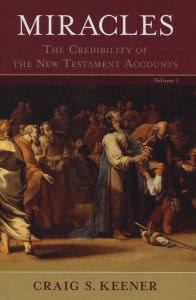Miracle Accounts beyond Antiquity, by Craig S. Keener
An excerpt from Miracles: The Credibility of the New Testament Accounts, by Craig S. Keener. From Pneuma Review Fall 2013.
From the introduction to Part 3, “Miracle Accounts beyond Antiquity”
Pages 209-210
The principle of analogy once used to argue against all ancient miracles (either the occurrence of some sorts of extranormal phenomena or their supernatural causation) now undermines that very argument. In Hume’s day, many Protestant theologians distinguished sharply between biblical and postbiblical miracles as part of their anti-Catholic polemic. Their polemic played into the Humean argument against ancient miracles based on the lack of many comparable modern claims. Many theologians in turn accommodated this nonmiraculous approach, further emphasizing the lack of postbiblical miracles and eventually often renouncing miracles altogether.
Today, however, abundant claims of miracles, particularly from the Majority World, challenge Hume’s skepticism about the existence of many credible eyewitnesses. Hume demanded “a sufficient number” of witnesses of unquestioned integrity and intelligence who would have much to lose by testifying falsely.1 In today’s academic climate, many who testify to miracles have much to lose even by testifying truly; but I shall first respond to Hume’s quantitative demand. In contrast to the environment assumed by Hume, today hundreds of millions of people claim to have witnessed miracles. Moreover, eyewitnesses claim what they believe are miracles even in the West, and this has been the case through most of history, even when Hume framed his argument within the theological framework of academic circles often reticent to acknowledge miraculous claims. Some of these eyewitness claims involve even the healing of blindness, the raising of the dead, and nature miracles. I will treat some of these subjects in turn in subsequent chapters: claims from the Majority World (chs. 7–9); Western history (ch. 10); the modern West (ch. 11); and some specifically dramatic claims like those involving blindness, death, or nature (ch. 12).
Virtually no one would suggest that all claims reflect clearly authentic miracles (see discussion in ch. 13). Nevertheless, such claims, however we interpret them, clearly exist on an eyewitness level and hence need not be excluded from first- and second-generation testimony in the Gospels and Acts. Statistics suggest the vast numbers of claims; my primary interest in chapters 7–12 is to illustrate some of the variety of sorts of cases involved in them. While the primary point of these chapters is not the interpretation of events, some of these reports may have a bearing on that question. At the least, given the vast number and variety of claims, one can no longer simply take for granted that uniform human experience a priori excludes extranormal events for which many observers would find a specifically theistic interpretation particularly persuasive (see discussion in chs. 13–15).
PR
This excerpt is from Craig S. Keener, Miracles: The Credibility of the New Testament Accounts, 2 volumes, Baker Academic, a division of Baker Publishing Group, 2011. Used by permission. All rights to this material are reserved. Material is not to be reproduced, scanned, copied, or distributed in any printed or electronic form without written permission from Baker Publishing Group.
Footnotes appear in the full digital issue of Pneuma Review Fall 2013 and in the book from which this excerpt is derived.
Category: Fall 2013, Pneuma Review, Spirit



